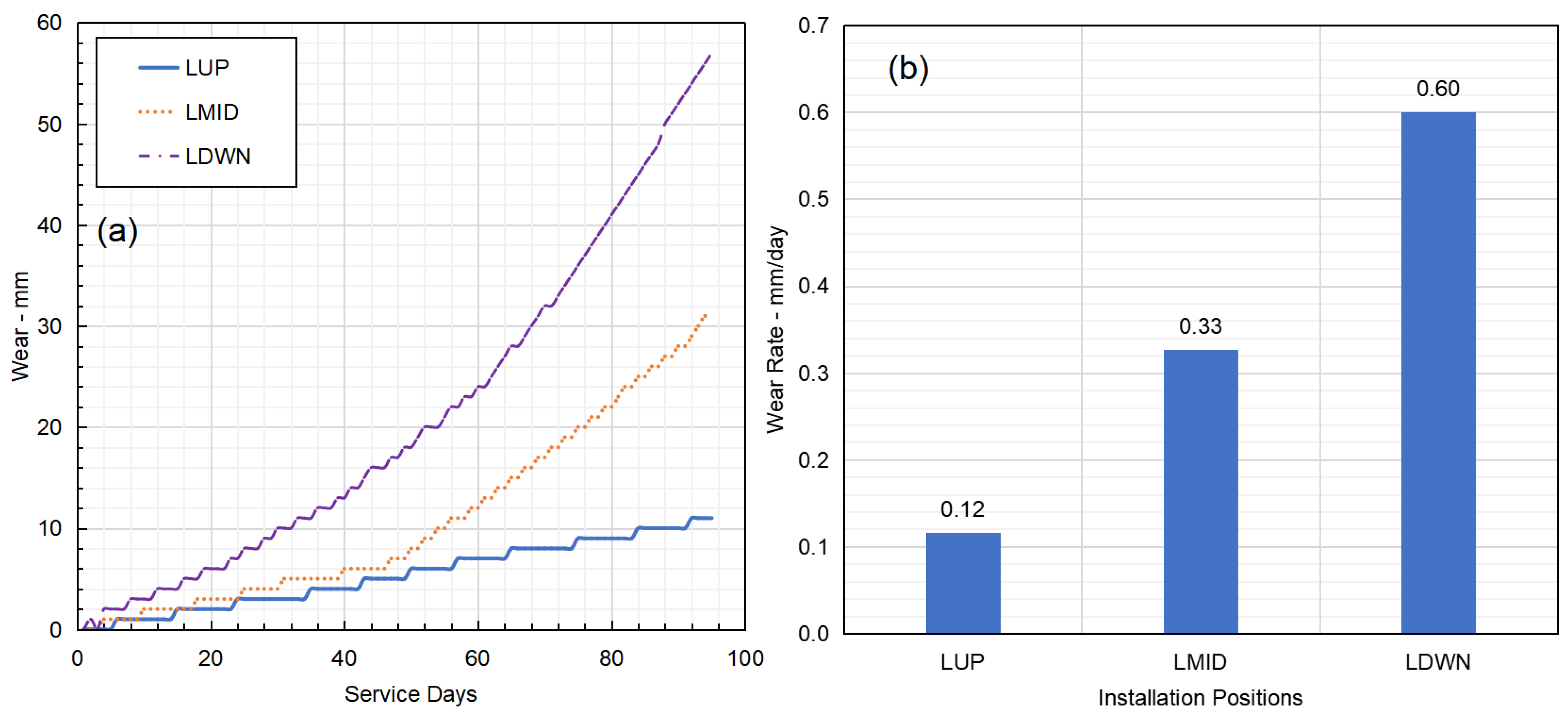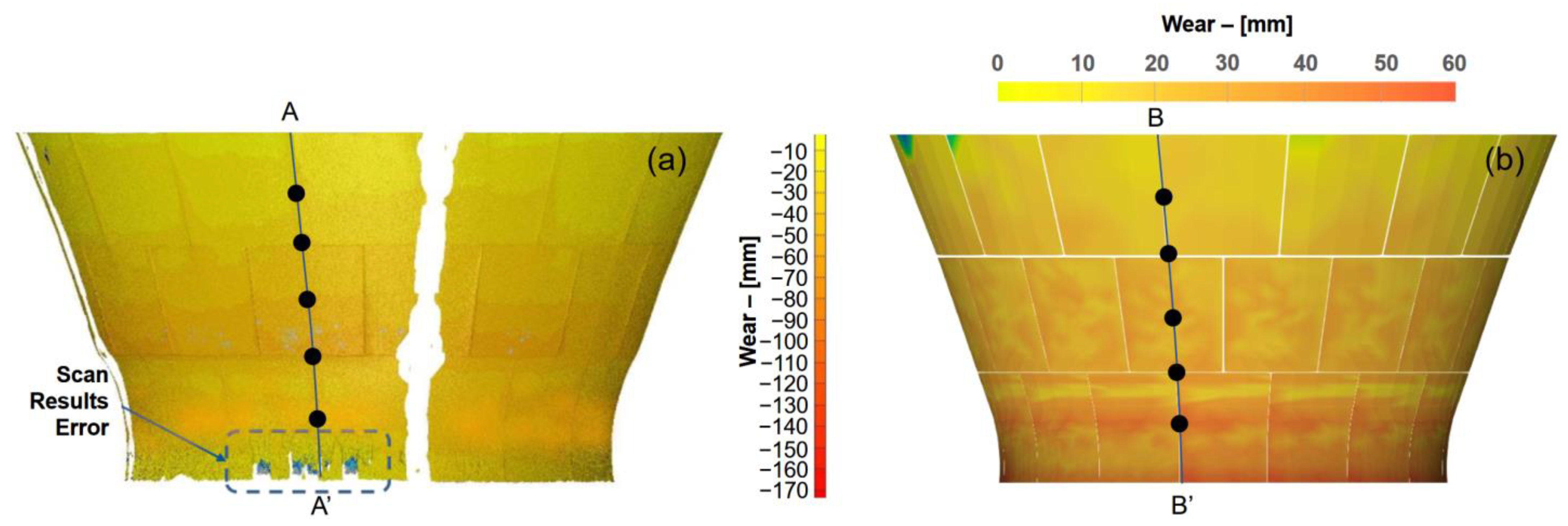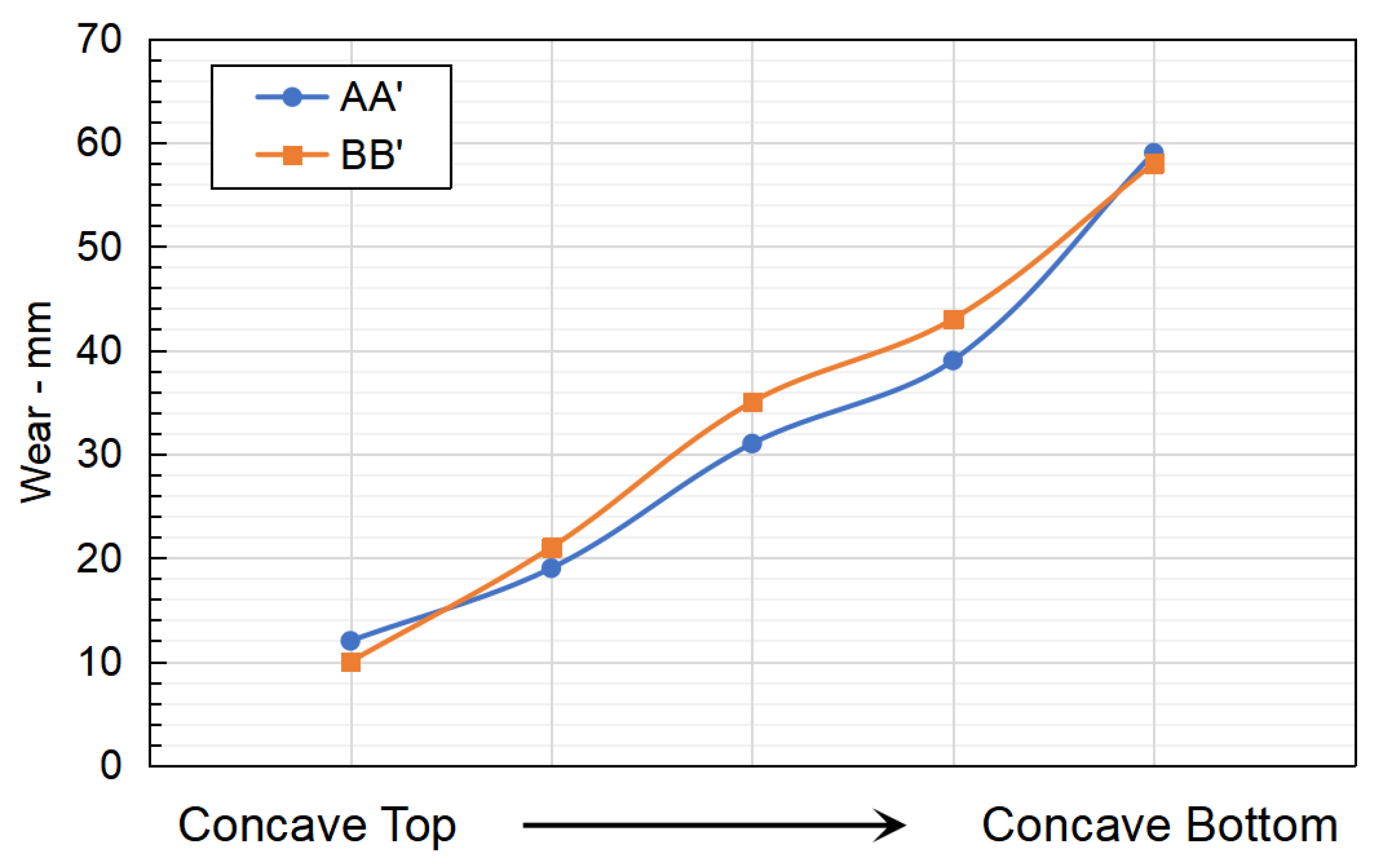Modelling of Gyratory Crusher Liner Wear Using a Digital Wireless Sensor
Abstract
:1. Introduction
2. Wear Sensor Development
3. Numerical Modelling Programme
3.1. Discrete Element Modelling
- is the normal contact force;
- is the tangential contact force;
- is the elastic stiffness for normal contact;
- is the normal overlap;
- is the viscoelastic damping constant for normal contact;
- is the normal relative velocity (normal component of the relative velocity of the two particles);
- is the elastic stiffness for tangential contact;
- is the tangential overlap;
- is the viscoelastic damping constant for tangential contact;
- is the tangential relative velocity (tangential component of the relative velocity of the two particles).
- is the rolling stiffness;
- is the relative angular velocity of the two particles in contact.
3.2. Particle Breakage Modelling
3.3. Numerical Setup
4. Results and Discussion
4.1. Digital Wear Sensor Measurements
4.2. Gyratory Crusher Modelling Results
4.3. Concave Global Wear Reconstruction
5. Conclusions
- The concave liner wear exhibited a non-linear correlation, which was initially slow and gradually ramped up towards the end of liner life.
- Concave liners near the discharge position of the gyratory crusher showed higher wear. And the wear continued to reduce towards the feeding position.
- The highest wear position in the mantle was indicated to occur at a similar position compared with concave liners; however, the wear on the mantle was more evenly distributed.
- Wear evolution results obtained using coupling digital sensor results and DEM wear modelling showed good agreement with laser scan measurement.
Author Contributions
Funding
Institutional Review Board Statement
Informed Consent Statement
Data Availability Statement
Conflicts of Interest
References
- Pryor, M.R. Mineral Processing; Springer Science & Business Media: Berlin/Heidelberg, Germany, 2012. [Google Scholar]
- Wills, B.A.; Finch, J. Wills’ Mineral Processing Technology: An Introduction to the Practical Aspects of Ore Treatment and Mineral Recovery; Butterworth-Heinemann: Oxford, UK, 2015. [Google Scholar]
- Kondrakhin, V.P.; Martyushev, N.V.; Klyuev, R.V.; Sorokova, S.N.; Efremenkov, E.A.; Valuev, D.V.; Mengxu, Q. Mathematical Modeling and Multi-Criteria Optimization of Design Parameters for the Gyratory Crusher. Mathematics 2023, 11, 2345. [Google Scholar]
- Zhang, W. Optimizing Performance of SABC Comminution Circuit of the Wushan Porphyry Copper Mine—A Practical Approach. Minerals 2016, 6, 127. [Google Scholar]
- Korman, T.; Bedekovic, G.; Kujundzic, T.; Kuhinek, D. Impact of Physical and Mechanical Properties of Rocks on Energy Consumption of Jaw Crusher. Physicochem. Probl. Miner. Process. 2015, 51, 461–475. [Google Scholar]
- Saramak, D.; Iwanów, Z.A. Influence of HPGR Operation on the Reduction of Bond’s Working Index of Crushing Product. IOP Conf. Ser. Mater. Sci. Eng. 2018, 427, 012016. [Google Scholar] [CrossRef]
- Kahraman, S.; Toraman, O.Y.; Cayirli, S. Predicting the Strength and Brittleness of Rocks from a Crushability Index. Bull. Eng. Geol. Environ. 2018, 77, 1639–1645. [Google Scholar]
- Köken, E.; Özarslan, A. New Testing Methodology for the Quantification of Rock Crushability: Compressive Crushing Value (CCV). Int. J. Miner. Metall. Mater. 2018, 25, 1227–1236. [Google Scholar]
- Xiao, Y.; Wang, C.; Wu, H.; Desai, C.S. New Simple Breakage Index for Crushable Granular Soils. Int. J. Geomech. 2021, 21, 04021136. [Google Scholar]
- Clarke, P.; Elias, I.; Kautto, J. Laser Scanning for Complete Wear History Capture and Life Cycle Data Analysis in the Mining Industry. Int. J. COMADEM 2015, 18, 21–25. [Google Scholar]
- Rosario, P.P.; Hall, R.A.; Maijer, D.M. Liner Wear and Performance Investigation of Primary Gyratory Crushers. Miner. Eng. 2004, 17, 1241–1254. [Google Scholar]
- Lindqvist, M.; Evertsson, C.M. Liner Wear in Jaw Crushers. Miner. Eng. 2003, 16, 1–12. [Google Scholar]
- Bembenek, M.; Krawczyk, J.; Zagórski, K.; Pawlik, J. On the Wear Mechanism of High-Chromium Gyratory Crusher Mantle Lining in Terms of the Assessment of the Used Material. Tribologia 2023. [Google Scholar] [CrossRef]
- Rosario, P.P.; Hall, R.A.; Maijer, D.M. Improved Gyratory Crushing Operation by the Assessment of Liner Wear and Mantle Profile Redesign. Miner. Eng. 2004, 17, 1083–1092. [Google Scholar] [CrossRef]
- Chen, Z.; Wang, G.; Xue, D.; Bi, Q. Simulation and Optimization of Gyratory Crusher Performance Based on the Discrete Element Method. Powder Technol. 2020, 376, 93–103. [Google Scholar] [CrossRef]
- Quist, J.; Evertsson, C.M.; Franke, J. The effect of liner wear on gyratory crushing—A DEM case study. In Proceedings of the 3rd International Computational Modelling Symposium (Computational Modelling’11), Falmouth, UK, 20–22 September 2011. [Google Scholar]
- Moncada, M.; Toledo, P.; Betancourt, F.; Rodríguez, C.G. Torque Analysis of a Gyratory Crusher with the Discrete Element Method. Minerals 2021, 11, 878. [Google Scholar] [CrossRef]
- Bruchmüller, J.; Van Wachem, B.G.M.; Gu, S.; Luo, K.H. Modelling Discrete Fragmentation of Brittle Particles. Powder Technol. 2011, 208, 731–739. [Google Scholar] [CrossRef]
- Delaney, G.W.; Morrison, R.D.; Sinnott, M.D.; Cummins, S.; Cleary, P.W. DEM Modelling of Non-Spherical Particle Breakage and Flow in an Industrial Scale Cone Crusher. Miner. Eng. 2015, 74, 112–122. [Google Scholar] [CrossRef]
- Cleary, P.W.; Sinnott, M.D.; Morrison, R.D.; Cummins, S.; Delaney, G.W. Analysis of Cone Crusher Performance with Changes in Material Properties and Operating Conditions Using DEM. Miner. Eng. 2017, 100, 49–70. [Google Scholar] [CrossRef]
- Cleary, P.W.; Delaney, G.W.; Sinnott, M.D.; Cummins, S.J.; Morrison, R.D. Advanced Comminution Modelling: Part 1–Crushers. Appl. Math. Model. 2020, 88, 238–265. [Google Scholar] [CrossRef]
- Potyondy, D.O.; Cundall, P. A Bonded-Particle Model for Rock. Int. J. Rock Mech. Min. Sci. 2004, 41, 1329–1364. [Google Scholar] [CrossRef]
- Lindqvist, M.; Evertsson, C.M. Development of Wear Model for Cone Crushers. Wear 2006, 261, 435–442. [Google Scholar] [CrossRef]
- Ou, T.; Chen, W. On Accurate Prediction of Transfer Chute Wear Using a Digital Wear Sensor and Discrete Element Modelling. Powder Technol. 2022, 407, 117680. [Google Scholar] [CrossRef]
- Parkin, R.M.; Bearman, R.A. Energy Conservation via Optimal Control of Cone Crushers. Proc. Inst. Mech. Eng. Part E J. Process Mech. Eng. 1994, 208, 165–170. [Google Scholar] [CrossRef]
- Qin, J.; Chen, W. Coupling of an IOT Wear Sensor and Numerical Modelling in Predicting Wear Evolution of a Slurry Pump. Powder Technol. 2022, 404, 117453. [Google Scholar] [CrossRef]
- Khalifeh, A.; Mazunga, F.; Nechibvute, A.; Nyambo, B.M. Microcontroller Unit-Based Wireless Sensor Network Nodes: A Review. Sensors 2022, 22, 8937. [Google Scholar] [CrossRef] [PubMed]
- Haque, K.F.; Abdelgawad, A.; Yelamarthi, K. Comprehensive Performance Analysis of Zigbee Communication: An Experimental Approach with XBee S2C Module. Sensors 2022, 22, 3245. [Google Scholar] [CrossRef] [PubMed]
- AlShuhail, A.S.; Bhatia, S.; Kumar, A.; Bhushan, B. Zigbee-Based Low Power Consumption Wearables Device for Voice Data Transmission. Sustainability 2022, 14, 10847. [Google Scholar] [CrossRef]
- Meroth, A.; Sora, P. Serial Peripheral Interface (SPI). In Sensor Networks in Theory and Practice; Springer: Berlin/Heidelberg, Germany, 2023; pp. 205–224. [Google Scholar]
- Cundall, P.A.; Strack, O.D. A Discrete Numerical Model for Granular Assemblies. Geotechnique 1979, 29, 47–65. [Google Scholar] [CrossRef]
- He, H.; Zheng, J.; Schaefer, V.R.; Cao, P.; Zheng, H. Simulation of Realistic Granular Soils in Triaxial Test Using Physics Engine. In Computational Particle Mechanics; Springer: Berlin/Heidelberg, Germany, 2023; pp. 1–16. [Google Scholar]
- Coetzee, C.; Katterfeld, A. Calibration of DEM Parameters. In Simulations in Bulk Solids Handling: Applications of DEM and Other Methods; Wiley: Hoboken, NJ, USA, 2023; pp. 1–40. [Google Scholar]
- Carr, M.J.; Roessler, T.; Robinson, P.W.; Otto, H.; Richter, C.; Katterfeld, A.; Wheeler, C.A. Calibration Procedure of Discrete Element Method (DEM) Parameters for Wet and Sticky Bulk Materials. Powder Technol. 2023, 429, 118919. [Google Scholar] [CrossRef]
- Misra, A.; Finnie, I. On the Size Effect in Abrasive and Erosive Wear. Wear 1981, 65, 359–373. [Google Scholar] [CrossRef]
- Stark, S.; Perkins, T.; Napier-Munn, T.J. JK Drop Weight Parameters: A Statistical Analysis of Their Accuracy and Precision and the Effect on SAG Mill Comminution Circuit Simulation; Australasian Institute of Mining and Metallurgy Publication Series; Australasian Institute of Mining and Metallurgy: Parkville, VIC, Australia, 2008; pp. 147–156. [Google Scholar]
- Morrell, S. How to Formulate an Effective Ore Comminution Characterization Program. In Proceedings of the MetPlant 2019, Perth, WA, Australia, 10–11 September 2019; The Australasian Institute of Mining and Metallurgy: Melbourne, VC, Australia, 2019; p. 5175. [Google Scholar]
- Morrell, S. Predicting SAG/AG Mill and HPGR Specific Energy Requirements Using the SMC Rock Characterisation Test. In Proceedings of the Randol Innovative Metallurgy Forum, Perth, WA, Australia, 21–24 August 2005. [Google Scholar]
- Ouchterlony, F.; Sanchidrián, J.A.; Genç, Ö. Advances on the Fragmentation-Energy Fan Concept and the Swebrec Function in Modeling Drop Weight Testing. Minerals 2021, 11, 1262. [Google Scholar] [CrossRef]
- Standard Specification for Woven Wire Test Sieve Cloth and Test Sieves. Available online: https://www.astm.org/e0011-22.html (accessed on 23 October 2023).
- Williams, K.C.; Chen, W.; Weeger, S.; Donohue, T.J. Particle Shape Characterisation and Its Application to Discrete Element Modelling. Particuology 2014, 12, 80–89. [Google Scholar] [CrossRef]
- Chen, W.; Wang, Z.; Wheeler, C.; Roberts, A.; Katterfeld, A. Experimental and Numerical Investigation on the Load Stability of Coal Cargoes during Marine Transport. Granul. Matter 2021, 23, 16. [Google Scholar] [CrossRef]
- Ayadi, S.; Hadji, A. Effect of Chemical Composition and Heat Treatments on the Microstructure and Wear Behavior of Manganese Steel. Int. J. Met. 2021, 15, 510–519. [Google Scholar] [CrossRef]
- Mishra, S.; Dalai, R. A Comparative Study on the Different Heat-Treatment Techniques Applied to High Manganese Steel. Mater. Today Proc. 2021, 44, 2517–2520. [Google Scholar] [CrossRef]
- Srivastava, A.K.; Das, K. Microstructural Characterization of Hadfield Austenitic Manganese Steel. J. Mater. Sci. 2008, 43, 5654–5658. [Google Scholar] [CrossRef]
- Jankovic, A. Comminution and Classification Technologies of Iron Ore. In Iron Ore; Elsevier: Amsterdam, The Netherlands, 2022; pp. 269–308. [Google Scholar]
- Richter, C.; Roessler, T.; Otto, H.; Katterfeld, A. Coupled Discrete Element and Multibody Simulation, Part I: Implementation, Verification and Validation. Powder Technol. 2021, 379, 494–504. [Google Scholar] [CrossRef]
- Aghababaei, R.; Zhao, K. Micromechanics of Material Detachment during Adhesive Wear: A Numerical Assessment of Archard’s Wear Model. Wear 2021, 476, 203739. [Google Scholar] [CrossRef]









| Variable | Value | Units |
|---|---|---|
| Particle density | 2600 | kg/m3 |
| Interparticle friction coefficient [42] | 0.5 | - |
| Wall friction coefficient [42] | 0.3 | - |
| Rolling friction coefficient [42] | 0.3 | - |
| Restitution coefficient | 0.3 | - |
| Poisson’s ratio | 0.3 | - |
| Young’s modulus | 1 × 107 | Pa |
| [18] | 3 | J/kg |
| [18] | 0.9 | kg/Jm |
| [18] | 10 | - |
| Time step | 1 × 10−6 | s |
Disclaimer/Publisher’s Note: The statements, opinions and data contained in all publications are solely those of the individual author(s) and contributor(s) and not of MDPI and/or the editor(s). MDPI and/or the editor(s) disclaim responsibility for any injury to people or property resulting from any ideas, methods, instructions or products referred to in the content. |
© 2023 by the authors. Licensee MDPI, Basel, Switzerland. This article is an open access article distributed under the terms and conditions of the Creative Commons Attribution (CC BY) license (https://creativecommons.org/licenses/by/4.0/).
Share and Cite
Ou, T.; Chen, W. Modelling of Gyratory Crusher Liner Wear Using a Digital Wireless Sensor. Sensors 2023, 23, 8818. https://doi.org/10.3390/s23218818
Ou T, Chen W. Modelling of Gyratory Crusher Liner Wear Using a Digital Wireless Sensor. Sensors. 2023; 23(21):8818. https://doi.org/10.3390/s23218818
Chicago/Turabian StyleOu, Tao, and Wei Chen. 2023. "Modelling of Gyratory Crusher Liner Wear Using a Digital Wireless Sensor" Sensors 23, no. 21: 8818. https://doi.org/10.3390/s23218818




